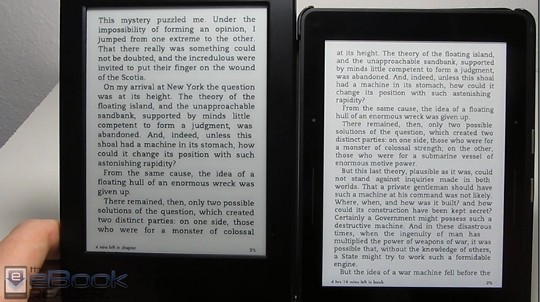For this review I’m comparing the Kindle Voyage with the $79 entry-level Kindle. I put together comparison reviews for each one against the Kindle Paperwhite a long time ago, so I figured the high-end model and entry-level model needed to get their own turn as well.
I don’t think most people realize that they are the exact same from a software standpoint; the Voyage does not have one single software advantage for the extra $120+.
All that additional cost is going to hardware upgrades, which includes a 300 ppi screen, a frontlight, a flush capacitive touchscreen, and page sensor buttons.
All current E Ink Kindles run the same software and offer all the same settings, layout, fonts, and reading features. The only difference software-wise when it comes to the Voyage and $79 Kindle are a few extra settings to adjust the hardware features, like the page button sensitivity and frontlight brightness.
The one exception with the Kindle Paperwhite’s software is it still supports Kindle apps and games, which have been phased out on the Voyage and new Kindle Touch.
It should also be noted that the current lineup of E Ink Kindles all have the same processor and offer the same amount of storage space, so none has an advantage over another. They all operate and function at the same speed. Turning pages, opening books, searching is just as fast on the $79 Kindle as it is on the $289 3G Kindle Voyage.
See the individual device reviews for more details: Kindle Voyage Review – $79 Kindle Review.
Differences: Kindle Voyage vs $79 Kindle
Here are the nine main differences between the Kindle Voyage and the entry-level $79 Kindle.
- Frontlight: The Kindle Voyage has a frontlight to illuminate the screen, which also makes the screen background appear whiter. The $79 has no light so it requires good lighting or a lamp like a paper book would in low lighting.
- Page Turn Sensors: The Kindle Voyage has page senor buttons on each side of the screen to turn pages instead of tapping the touchscreen. You can adjust the pressure required to press and there’s also the option to set it so you feel a subtle vibration when pressed. Both features can be turned on and off.
- Screen: Both Kindles have the same size 6-inch E Ink screen, but the Voyage has a higher resolution display with almost twice as many pixels (300 ppi vs 167 ppi), which makes text and fine details appear clearer. The Voyage also uses newer screen technology with better contrast (Carta vs Pearl).
- Battery: According to Amazon’s battery life claims, the Kindle Voyage’s battery can last up to 6 weeks per charge and the $79 Kindle’s battery can last up to 4 weeks.
- Design: Each Kindle looks like it was designed by completely different companies. The entry-level Kindle is blocky, thick, and it looks rather cheap with a clunky plastic frame. The Voyage is very thin, light, and more refined and classy with its flush touchscreen and angled edges.
- Size: Kindle Touch: 6.7″ x 4.7″ x 0.40″ – Weight: 6.7 oz. Kindle Voyage: 6.4″ x 4.5″ x 0.30″ – Weight: 6.3 ounces; 6.6 oz 3G model.
- Touchscreen: The basic Kindle has an infrared touchscreen and the Voyage has a capacitive touchscreen. Both support pinch-zooming so there’s no usability difference between the two.
- 3G Wireless: The Voyage has the option for 3G wireless; the basic Kindle is Wi-Fi only.
- Price: The basic Kindle is $79 for the Special Offers model and $99 for the non-ad model. The Kindle Voyage starts at $199 with ads, $219 without, plus there’s the 3G version for $70 more.
More comparison info between these two Kindles and all the other models past and present can found on the Kindle Comparison Table.


I don’t think most people realize that they are the exact same from a software standpoint; the Voyage does not have one single software advantage for the extra $120+.
And for those who took advantage of the Staples rebate offer of $30 for a Kindle during the Christmas season, that difference in price becomes $170.
The Kindle 6 handles PDFs a lot better than the older versions, which makes the $30 price even better.